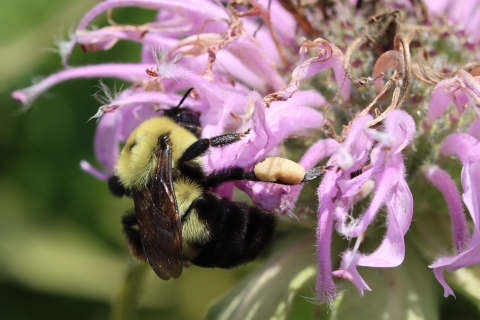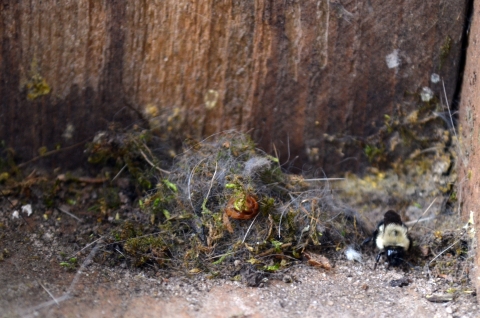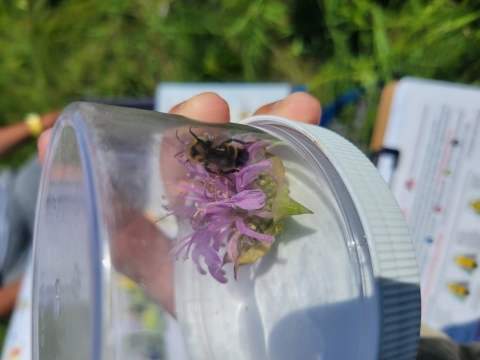Return of the Queen
Bumble bee queens emerge from hibernation as early as April and immediately begin their search for a home to start a colony. A queen busily takes on the responsibilities of foraging for food, defending her nest and tending to her young until her worker bees are mature. Typically emerging in early summer, all worker bees are female. Workers from most bumble bee species have structures on their hind legs called corbiculae, or “pollen baskets”, which they use to collect pollen to bring back to their colony. If you spot a bright orange or gold lump on a bumble bee’s leg, you can bet it’s a female! Males and new queens also do not emerge until later in the summer.
Social Parasitism
Not all bumble bee queens are fortunate enough to maintain their colony through the summer, though, due to competition from their own species along with a socially parasitic subgroup known as the cuckoo bumble bees. The term “socially parasitic” comes from the fact that they exploit the entire colony in addition to the queen in their quest to have another species tend to their young. While this practice may make cuckoo bumble bees seem immoral, social parasitism is common even among populations that do not need it to survive! Bumble bee queens that emerge late in the season or face complications in establishing their own nest may attempt to steal the nest and workers from another queen of her own species. When nest usurpation occurs within one species, it is called “facultative social parasitism” because this sly strategy is only deployed under certain ecological circumstances. Cuckoo bumble bees are “obligate brood parasites”, meaning their queens are unable to establish nests on their own and cannot reproduce without their hosts.
Ecology of the Cuckoo Bumble Bee
A cuckoo bumble bee queen will take over a nest by killing or subduing the original queen. She has special adaptations, including stronger mouth parts, a harder exoskeleton and a more powerful sting to help her win this fight. She will then trick the workers into feeding her and raising her young using chemical cues. Because cuckoo bumble bees rely on other species to feed their larvae and do not need to forage for the colony, their females will not have pollen baskets on their legs. While cuckoo bumble bees play a limited role in pollinating plants, their value in the ecosystem lies in their ability to regulate bumble bee communities. By parasitizing specific species, they can prevent these host species from dominating less competitive bumble bees in the same ecosystem, like how a predator would regulate a prey population.
Since each cuckoo bumble bee species relies on specific host species, they are rarer to find and can succeed only when they share habitat with their target hosts. One species, the lemon cuckoo bumble bee, is dependent on a few bumble bee species common to our area: the half-black bumble bee, the two-spotted bumble bee and the common eastern bumble bee. This allows them to be one of the more abundant cuckoo bumble bees in Minnesota. Other cuckoo bumble bee species are not so fortunate, and their populations are greatly affected as their host species become scarcer. Because of their key association with other species, the presence of a cuckoo indicates that there must also be healthy populations of the host species in the area.
Minnesota Valley’s Bumble Bee Efforts
Each summer our biology team conducts bumble bee surveys to help us assess the success of our restoration projects in providing habitat for bumble bees. We are able to learn how many species are using these sites and monitor for the presence of the endangered rusty patched bumble bee. In recent years, we have found lemon cuckoo bumble bees on the refuge and wetland management district wetland management district
A wetland management district is a U.S. Fish and Wildlife Service office that manages waterfowl production areas in one or more counties. Waterfowl production areas are small natural wetlands and grasslands that provide breeding, resting and nesting habitat for waterfowl, shorebirds, grassland birds and other wildlife. The Fish and Wildlife Service acquires waterfowl production areas under the authority of the Migratory Bird Hunting and Conservation Stamp Act, primarily using funds from the sale of Federal Duck Stamps. The Refuge System’s 38 wetland management districts comprise thousands of waterfowl production areas – almost all in the Prairie Pothole Region of the Northern Great Plains.
Learn more about wetland management district , which tells us we are likely supporting stable, healthy populations of one or more of the host species.
Help Native Bees in Your Neighborhood!
You can help create a network of habitat for these busy insects and many other pollinators by adding native plants to your home in a garden or outdoor potted planter. It is important to provide flowers that bloom at different times so that there are always high-quality food resources available. You can support pollinators by including both early- to mid-season bloomers, like prairie clover, and late-season bloomers, such as aster and goldenrod. While the bees may not say “thank you,” encountering one of these fuzzy critters is a reward in itself.







